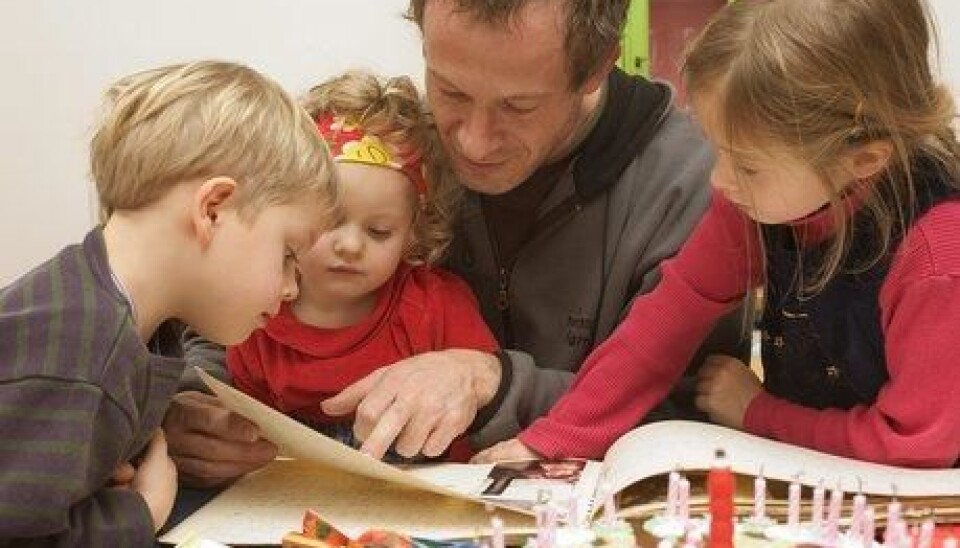This article was produced and financed by Oslo Metropolitan University

Working conditions more important than the lack of men
Researcher does not share general concerns about the low proportion of men and the lack of personnel with relevant education in Norwegian day-care centres.
Denne artikkelen er over ti år gammel og kan inneholde utdatert informasjon.
It is more important that day-care centre employees have good working conditions, that goals set for the centres are reached, and that recruitment to the profession is as good as possible.
Researcher Mette Løvgren is writing her PhD thesis at the Centre for the Study of Professions and is currently analysing questionnaires from around 2,400 day-care centre employees.
Perform the same tasks
Løvgren examines the division of labour between assistants and educational supervisors, and a common concern is that work duties in day-care centres are not divided according to competence and that, as a consequence, pre-school teacher competence is not fully utilised.
"The division of labour is less than what might be expected when we have two groups, one of which has relevant education and the other not. Educational supervisors perform much the same tasks as the assistants," says Løvgren, who emphasizes that close contact with children in routine activities such as dressing and undressing is necessary so that pre-school teachers can use their competence.
Not easy to see differences

The PhD candidate's research shows that it is not easy to see the differences between an assistant and an educational supervisor in other areas, either. But does this mean that these two groups work in the same way and that this has nothing to say for the quality of the work performed?
"No, I don't think we can draw that conclusion," says Løvgren.
"The employees answer in much the same way in the survey when asked about, for example, what they consider to be important in working with children: care-giving, teaching, verbal skills, etc. But educational supervisors performs other types of tasks, so all in all they do more."
"Nor do we know how employees actually perform their work. Perhaps it is unreasonable to expect assistants and educational supervisors to perform such different tasks. Perhaps we should think instead that they do much of the same, only in different ways."
Almost all women
Almost all employees in day-care centres are women. Political ambitions to increase the proportion of men have been expressed, and recruitment campaigns have focused on this particular issue. Several assumptions about men and women and their work underlie such ambitions.
"Some think that men and women are different and that children need to be exposed to both genders in the day-care centre. Others point out that more men in the day-care centres would boost professional status and wage levels. There are many arguments in favour of recruiting more men to work in day-care centres, but in order to find out whether recruiting more male employees would have these positive impacts, we would need to conduct further studies," says Løvgren.
Gender-based tasks?
Mette Løvgren is therefore investigating whether female employees perform different tasks in day-care centres with and day-care centres without male colleagues.
Previous studies indicate that – since it is common to think of men and women as different – having more men could lead to gender roles that are more traditional rather than less, which is another argument in favour of recruiting more men in day-care centres.
Løvgren examines this by comparing participation in specific tasks performed by employees in day-care centres with no male employees and in day-care centres with one, two, three or more male employees. The findings show that the more men there are working in a day-care centre, the more often the female employees change nappies and the less often they take part in physical activities with the children.
"In other words, it seems that having more male employees in a day-care centre leads to more traditional gender roles among the employees," says Løvgren, but emphasizes that the effects are minimal and that several factors show no change.
The tasks suit everyone
Strangely enough, attitudes do not follow the same direction. On the contrary, both male and female day-care centre employees say that they consider most of their tasks to be equally suitable for men and women.
"This analysis is currently in progress, and I'm looking forward to seeing what the final results show," says Løvgren.
Must be more aware
Løvgren stresses that there is still a need continue efforts to recruit more men to work in day-care centres, but that the reason for doing so is not necessarily the one we assume, and that employees must be more aware of how labour is divided and of which gender roles each employee is given the opportunity to perform.
"At the same time, occupational roles are not designed in a vacuum; parental expectations are probably important."
Not for anyone
The next part of Løvgren's PhD thesis will deal with who works in day-care centres.
"Who are they, and where do they come from?" I want to get closer to an answer as to why working in day-care centres is given such poor recognition, both in terms of pay and social status. It is an important and often difficult job, but I think the general perception is that anyone can do it."
"The ambitions for and expectations of what day-care centres and their employees should achieve in terms of children's individual development correspond poorly with attitudes like that," says Løvgren.
-------------------------
This article was first published in HiOA Mag, HiOA's research magazine, and forskning.no.































